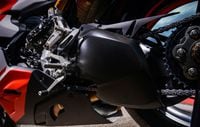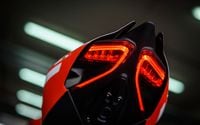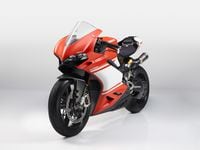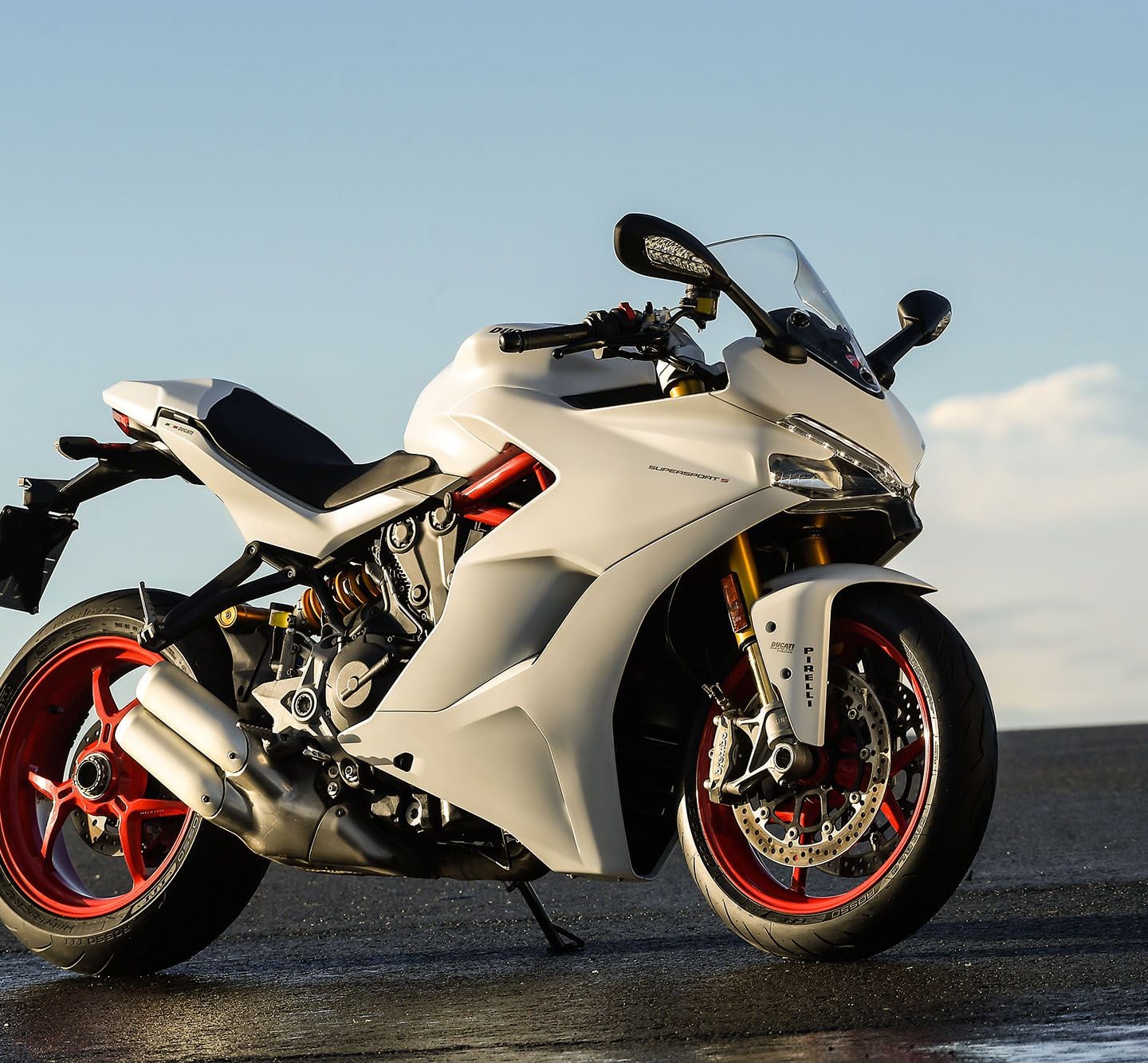Ducati's new 1299 Superleggera is a Roman orgy of high performance motorcycle design. It's the most powerful and sophisticated twin-cylinder production motorcycle ever built. Its balance of brute force, intelligence and Italian grace establishes the bike as a 21st century garage icon. Too bad you can't have one. Unless you pre-ordered. According to Ducati's marketing department, all 500 of the edition have been sold, "Unless you ready to buy - then we find 'a you one." Seriously. Actual quote. I love Italians. They're my kind of crazy.
So if they're already all gone, why am I in Bologna? And why bother with marketing? Call it Italian logic. Existential questions aside, there's still lots to discuss. I arrived at the Ducati factory in the Borgo Panigale suburb on a lovely spring morning. After niceties... and espresso... my minders herded me down a long hallway lined with championship-winning racebikes. I entered a white lounge littered with exotic motorcycle components and one sultry superbike.
My time with the 1299 Superleggera was brief. I gazed into her eyes, twisted her throttle and caressed her carbon bodywork. I imagined the two of us holding hands in romantic fourth-gear sweepers. Then I watched a video presentation. Sadly, there was no riding. Sniff.
Tech
The Superleggera's parts are almost pornographic. Racing-bred two ring pistons are 116mm in diameter, the size of a coffee cake. Titanium valves and connecting rods are the sprinkles. Compression is 13:1, but it'll run on gas from the Kwik Mart pump. The crankshaft is carved and knife-edged with a hollow crankpin and heavy Tungsten counterweight inserts. Stroke is 60.8mm, curiously close to my old 650 Pantah's 61.5mm. Claimed power is incomprehensible- over 215 horsepower, with 108 pound-feet of torque. If that ain't enough, there's a track kit with Akrapovič exhaust system that's nine pounds lighter and uncorks 10 more hp. Too much is never enough. I noticed a sculpted pivot shaft on the throttle body and an added lip on the butterfly valve for cleaner flow. Each engine is signed by the assembly artist. During our meeting, Engine Project Engineer Andrea Cucculelli stated 12,000-kilometer service intervals... with a straight face. He mentioned this engine costs twice as much to produce as the 1299 Panigale's.
Weight savings are obsessive and manifested mostly through exotic materials. Dry weight is a claimed 344 pounds—23 fewer than the 1299 Panigale. Engine internals alone are 5 pounds lighter.
She walks in carbon fiber. Wheels, monocoque frame, swingarm and subframe are all the first carbon instances in a production motorcycle. Project Manager Federico Valentin related his challenge in creating the swingarm. Autoclave timing was critical. I fondled a disembodied unit noting front and rear aluminum pivots mated seamlessly to the carbon weave using generous radii. It’s incredibly light and strong.
Öhlins forks are ovalized. The uppers are trimmed laterally for weight savings while maintaining larger longitudinal diameter for braking stiffness. The rear shock is lighter than it looks—the titanium spring is tricky.
Otherwise invisible production engineering makes the execution seem effortless. Ducati’s supply chain management is aerospace-grade and allows tracking back to material suppliers. That’s 21st century quality.
Electronics
Ducati dreambikes have always been fast as Texas jackrabbits. Traction control on earlier homologated specials like the 996 SPS consisted solely of your right hand. Highsides happened. Mere mortals beware. But this bike is different.
The 1299 Superleggera’s electronics package neatly fits 200+ horsepower into your throttle hand. All that’s missing is a gift tag and a bow. Other vehicle dynamics features would make a math teacher slobber. A 6-axis Inertial Measurement Unit indicates your position: you are here. The computer utilizes the throttle butterfly, spark advance, and fuel-injection variables to adaptively control wheel slip. It not only observes, it predicts. The result: precise rear wheel traction control.
Ducati Slide Control now aids corner exits. Launch and wheelie control make standing starts with 108 ft lbs seamless. Engine Brake Control matches rear wheel and engine speeds using the throttle butterfly. In race mode, Cornering ABS is an electronic floodlight illuminating the trail braking traction limit of the front tire. This bike makes “fast” easy.
Reflection
Bologna's efforts have evolved since the earliest Superlight. The 1992 version was an air-cooled 900SS with lighter two- piece Marvic/Akront rims, solo seat and carbon-fiber costume jewelry. Ducati basically slapped yellow bodywork and some marginally lighter parts on a 900SS and called it Superlight. The result was vaguely interesting. Those bikes still sell for twice the cost of a baseline 900SS. But they're not twice as good, especially considering their tendency to crack frames, wheel spokes, swingarms and engine studs. The 1199 Superleggera of 2014 was another matter entirely, trimming pounds from the stock 1199 Panigale and adding power and intricacy. The 1299 Superleggera is a whole other pile of pasta.
Wrap-up
In my mind, Ducati's new dreambike is close to a Pro Superbike from this decade. Want a world championship? Jump aboard and set the wayback machine for 2010. Just add talent. Speaking of racing, Official Test Rider Alessandro Valia rode a race-kitted Superleggara to a third-place Chinese Superbike finish in Zhuhai, China in March 2017. He told me he left the stock traction control and ABS systems on. Race technology trickles down quickly at Ducati.
One word summary: Seamless. From design to production to power delivery to handling, the 1299 Superleggera exudes seamless performance. Ducati’s new dreambike clearly demonstrates the company’s engineering prowess and production capabilities. The 1299 Superleggera is a significant benchmark for production superbikes. You may have to do a deal with the mafia for one...or maybe just check Craigslist in six months.











/cloudfront-us-east-1.images.arcpublishing.com/octane/APDSGNLMSU55JVEBWILWGCAD6E.jpg)












/cloudfront-us-east-1.images.arcpublishing.com/octane/TNOU5DNE2BC57MFPMGN2EIDXAM.jpg)
/cloudfront-us-east-1.images.arcpublishing.com/octane/GTCXACQGJ5HAPDTGWUQKDEH44E.jpg)
/cloudfront-us-east-1.images.arcpublishing.com/octane/S35YGSEMEZB4BLTDJTSZPF4GLA.jpg)
/cloudfront-us-east-1.images.arcpublishing.com/octane/5UOT6HPX2JFMRJAX6EH45AR4MQ.jpg)
/cloudfront-us-east-1.images.arcpublishing.com/octane/OKWOJWAKP5EP3OACCRRWPCIX2Q.jpg)
/cloudfront-us-east-1.images.arcpublishing.com/octane/2WF3SCE3NFBQXLDNJM7KMXA45E.jpg)
/cloudfront-us-east-1.images.arcpublishing.com/octane/G4MG6OUCJNBSHIS2MVVOTPX65E.jpg)
/cloudfront-us-east-1.images.arcpublishing.com/octane/IIGGWFOTOJGB7DB6DGBXCCMTDY.jpg)
/cloudfront-us-east-1.images.arcpublishing.com/octane/QSTCM6AVEZA5JJBUXNIQ3DSOF4.jpg)
/cloudfront-us-east-1.images.arcpublishing.com/octane/U4I7G625B5DMLF2DVIJDFZVV6M.jpg)
/cloudfront-us-east-1.images.arcpublishing.com/octane/B6XD6LS6IVCQPIU6HXDJSM3FHY.jpg)
/cloudfront-us-east-1.images.arcpublishing.com/octane/ICL63FEDDRDTTMINYICCEYGMDA.jpg)
/cloudfront-us-east-1.images.arcpublishing.com/octane/FCGZHQXRBZFLBAPC5SDIQLVF4I.jpg)
/cloudfront-us-east-1.images.arcpublishing.com/octane/WNOB6LDOIFFHJKPSVIWDYUGOPM.jpg)

/cloudfront-us-east-1.images.arcpublishing.com/octane/X33NU3E525ECRHXLNUJN2FTRKI.jpg)
/cloudfront-us-east-1.images.arcpublishing.com/octane/6KKT5NNL2JAVBOXMZYS5ZO76YA.jpg)
/cloudfront-us-east-1.images.arcpublishing.com/octane/J5RKG5O455GMPGQRF2OG6LRT7A.jpg)
/cloudfront-us-east-1.images.arcpublishing.com/octane/GX2CIZKQVRH2TATDM26KFG2DAE.jpg)
/cloudfront-us-east-1.images.arcpublishing.com/octane/ZWIDYSAKQZHD5BHREMQILXJCGM.jpg)
/cloudfront-us-east-1.images.arcpublishing.com/octane/CYUHJZCTSJCH3MRAQEIKXK7SCQ.jpg)
/cloudfront-us-east-1.images.arcpublishing.com/octane/LKOFINY56FCXJCANJ5M7ZDQUBY.jpg)
/cloudfront-us-east-1.images.arcpublishing.com/octane/4NBPDACMWJH63JQYJVK3QRBDZI.jpg)
/cloudfront-us-east-1.images.arcpublishing.com/octane/KKHQHRR3FJGX7H2IPU6RALMWG4.jpg)